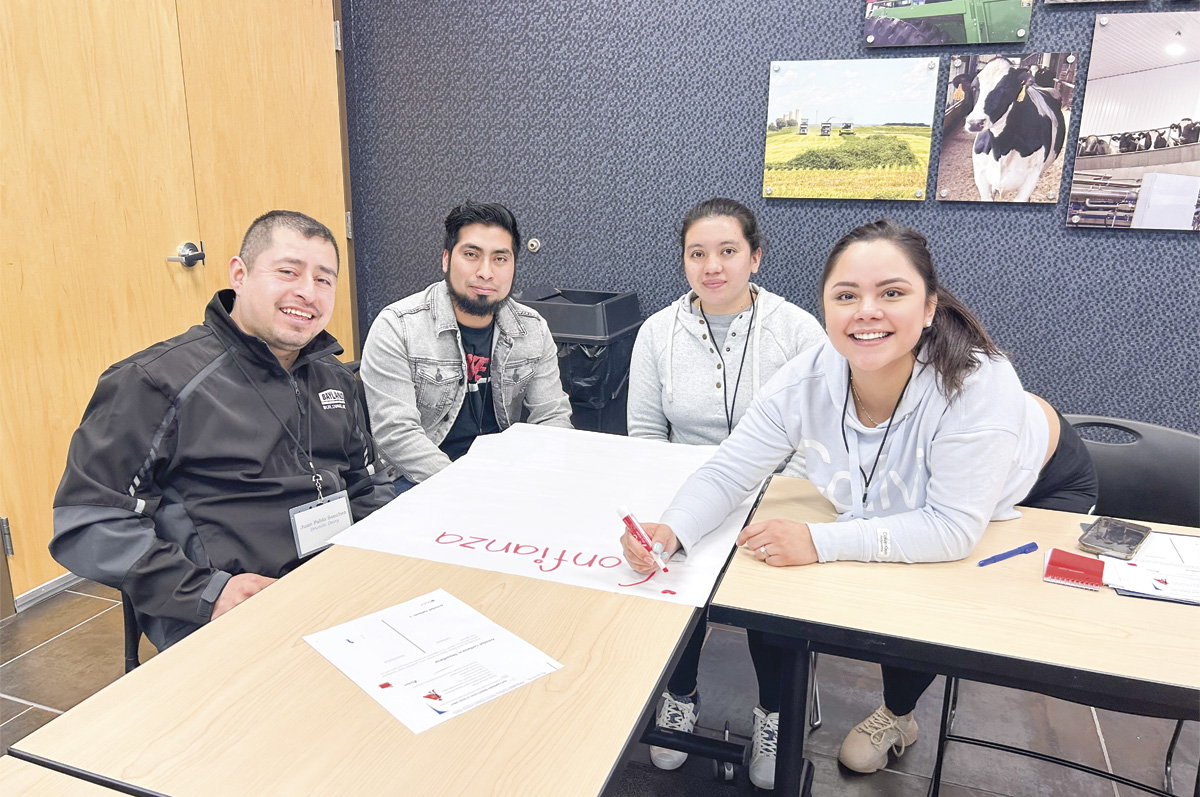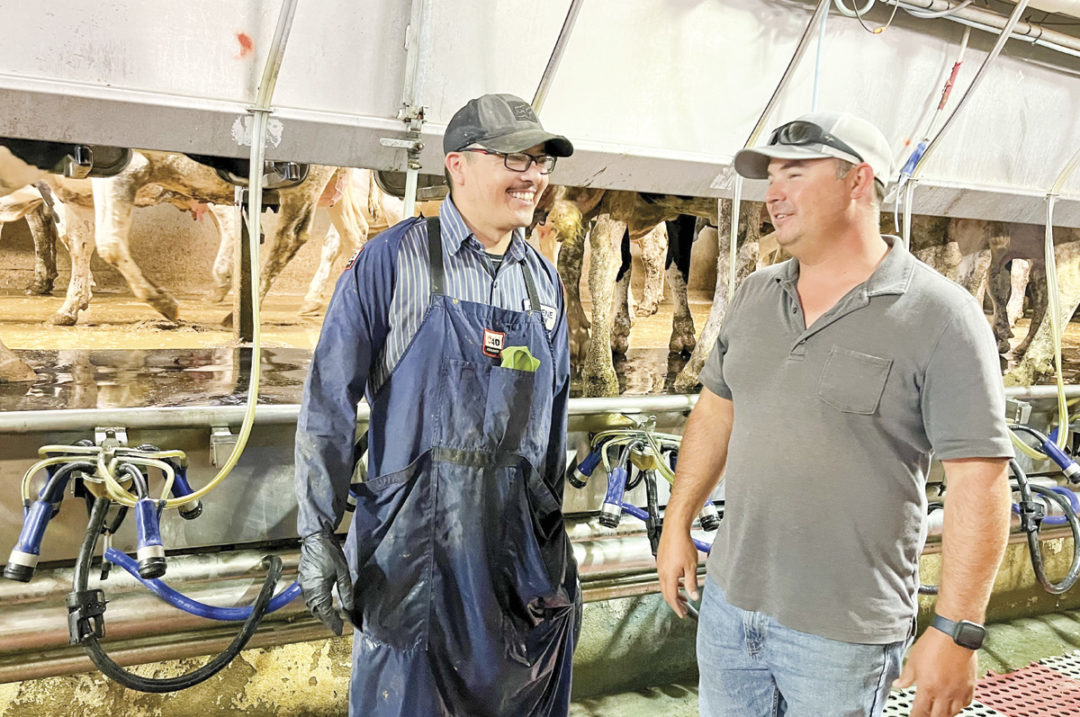Regardless of whether your farm’s workforce includes two family members or 100-plus employees, developing an effective training program can help make the operation more effective and efficient while creating a fulfilling workplace for everyone involved.
While training takes many forms and varies greatly from one dairy to the next, two common goals among producers are to increase employee engagement and to grow employee skill sets. Video training, interactive sessions and on-farm mentoring and leadership programs are three of the many ways dairy producers are preparing their teams for current and future responsibilities on the farm.
Bob Milligan, who consults with and coaches producers on many issues related to leading and supervising people, agrees that training is an area of opportunity on many dairy farms.
“My greatest takeaway is that employees desire training more than employers think they want training,” Milligan says. “I am convinced that training and development is the greatest competitive disadvantage small and family businesses – farms – have compared to large [businesses] with a human resource department.”
Communication skills, goal and expectation setting, and balancing responsibility and authority are three areas that are commonly missed by producers during training, he says.
He adds that training encompasses more than the skills training typically associated with the term, including:
- Training to help employees improve performance in their current job, which can include improvement in current tasks or learning an additional task.
- Development and learning beyond the scope of their current job, which is future-oriented to prepare for future opportunities, including promotions.
- Career planning, focused on everything from hiring to compensation to development, is critical to future farm success.
Of the three areas, career planning is more structured than the others, and there is some overlap with development, Milligan says.
“I have clients who have dramatically increased the quality of their workforce by being more career-focused,” he adds. “A great start is to develop a training or development plan and keep it updated, especially at the annual meeting with employees that I prefer to be a stay meeting rather than an annual review,” he says.
Video training
Cody Vander Dussen, his dad, Randy; and four of his brothers manage four dairies in Clovis, New Mexico. He and his brother, Bryan, manage West Wind Dairy, where they milk around 2,300 cows 2X-milking with about 18 employees.
Onboarding new employees at West Wind Dairy includes video training to introduce them to key concepts important to the employee’s new position and shadowing other employees to gain hands-on experience. After the initial onboarding process, all employees participate in regular training sessions, which involve video and in-person training on a variety of topics.
“We use videos to teach new employees about cow handling, calf handling, down cow problems and general animal husbandry,” Vander Dussen says. “They watch these videos within the first few days, depending on which shift they start on, and we have a supervisor there to help answer any questions and to make sure they are paying attention and not distracted with their phones. Tractor and loader drivers also go through an equipment training program and also in-person training talking about the hazards of pinch points, the spinning power takeoffs (PTOs), silage pile collapse hazards – that kind of information. We do those safety trainings at least annually to help remind them of the dangers of all the equipment and to keep them safe.”
About 80% of their training is video training, especially during the onboarding process. Additionally, Dr. Robert Hagevoort from New Mexico State University (NMSU) will come out to the farm and do in-person training on animal handling, as well as other trainers from various industry companies.
“Videos have a lot of good information, and over time they are improving to include better graphics, better illustrations showing what is happening, etc.,” Vander Dussen says. “Training videos do great the first few times, but nothing compares to in-person trainings.”
Interactive training
After the initial onboarding process, all employees at West Wind Dairy and the other dairies managed by the Vander Dussen family participate in regular training sessions, which involve video learning and in-person training on a variety of topics.
“I think in-person trainings always go better,” he says. “If you can get your employees physically there and engaging with each other and the trainer, that’s better.”
Vander Dussen describes one training that was especially memorable for his team.
“A few years ago, we had a calving training where they brought in a life-size model cow that they would put a life-size model calf in and twist it to mimic having a twisted uterus or backward calf,” he says. “Those guys got to put on gloves, use J-lube and try to figure out how to get that calf out and the best techniques to learn.”
The hands-on nature of the training provided an opportunity for employees to learn best practices, which will help them when they are in a real-life situation requiring these skills.
“A lot of these guys get really nervous about pulling a calf, but when they get into a situation like this during training they can take their time, and they have a better way to see what they are feeling,” Vander Dussen says. “So, as the trainer, Dr. Juan M. Piñeiro with Texas A&M Extension, is having them try to pull the calf out of the life-size cow, he’ll have another model calf there on the table. He’s like, ‘All right, what are you feeling?’ and they say, ‘I feel this leg.’ So he’ll put that leg into that position, and he will mimic what they are feeling with the calf on the table next to them, so they can see what the calf was doing. And then they know what to do to get it to pull out or to line it up to help the cow calve. At first, the guys were really nervous, but at the end of it, employees from the four dairies were like, ‘OK, we can pull it faster than you guys.’ It turned into a good, healthy competition.”
They have about four in-person trainings each year, lasting about an hour on various subjects, with video training in between if there’s a need for a refresher on a specific topic. Some trainings will involve employees from all the dairies, while others will be done by each dairy for their employees.
“If it’s a topic such as hoof trimming, calf pulling, down cow training, stuff like that, we will do it as a whole group, but if it is something more specific per dairy [such as] milking procedure or individual hospital treatment procedures, then we will do it separately, so we aren’t mixing procedures and guys aren’t getting confused,” Vander Dussen says.
Video training is typically shorter and can fill in as a more spontaneous learning opportunity, depending on which topics need to be addressed and discussed. They use video training from several sources, including the FARM Program, NMSU, West Texas A&M and other universities that have collaborated together to create a variety of videos to choose from.
“Industry companies coming in with different trainers gave us the opportunity to start giving the guys different information because you can watch the same video 10 times and think, ‘OK, I’ve seen this. This is boring and I don’t want to watch this again,’” Vander Dussen says.
The key to increasing employee engagement during training is to have an interactive trainer who is fluent in the language employees are most comfortable with who gets them engaged and explains the “why” behind what they are learning. It is more about the style of the trainer than the specific topics they are teaching, he says.
“That makes a huge difference,” he says. “The in-person trainings – especially the really interactive ones with great trainers who get employees involved and laughing – are 100 percent the way to go if you can. Our guys will be talking about it for days and that’s when you know it made a difference.”
On-farm leadership training
In addition to onboarding and other regular training, Milk Source LLC in Wisconsin created Milk Source University as a way to mentor their farm’s future leaders and managers. Each class includes 20 to 30 employees from across Milk Source’s five dairies and other associated operations who spend 64 hours over the first year and 30 hours the second year learning about communication, goal setting, time management, feedback, problem-solving, dealing with healthy conflict and other relevant topics that will help them grow their leadership skills. Topics vary and evolve from one class to the next.
“We run it like a college – year one is undergrad and the second year is like being a grad student,” says Avi Stern, director of public affairs for Milk Source. “So, by the time they are promoted to a senior leadership position on the farm, they’ve gone through the program for two years. We teach the classes primarily in Spanish. We are trying to reach them where they are most comfortable.”
Some employees nominate themselves for the program while managers also identify employees on their team that have leadership potential, according to Juan Quezada, director of training and development for Milk Source, LLC, who manages Milk Source University along with Santiago Ledwith, who is a consulting executive leadership coach.
“In the class, we don’t teach how to drive a skid steer or a tractor or how to treat a cow,” Quezada says. “It’s about the people, and it’s very important for us to help the employees find out that they can become a great dairyman because they took the class and because they understand what they can do with this knowledge as we empower them to be a good leader.”
The class meets on the first and second days of each month. Quezada also gathers the class for a video or conference call mid-month to check in, answer any questions they have and learn how they are starting to apply the information they learned.
“We could do all of this in one week and be done, but this is too much information, so we try to split it between multiple classes,” he says.
In addition to monthly classes and mid-month check-ins with Quezada and Ledwith, employees are divided into groups and tasked with putting together and presenting a PowerPoint presentation on any topic they want to share with their co-workers as part of a final group project.
“We have a mixture of generations, men, women, some people who are experienced veterans on our farms and others who are young, rising talent and it’s interesting to see how they interact when we put them into these different groups,” Stern says. Quezada agrees. “With different generations, everyone can help each other,” he says.

Leadership training at Milk Source includes team projects that bring together rising talent from multiple locations to share ideas and brainstorm solutions. Photo courtesy of Milk Source LLC.
Despite the length of the class and the amount of information presented, Quezada says the most common thing he hears from employees is that they want more.
“They tell me they need more classes, and they need more time,” he says. “Even though they spend a lot of hours in the class, they need more.”
While taking the class, employees who may have not considered themselves a leader before start to realize their own leadership potential.
“After employees take the class, they say, ‘Wow. I’m a good leader, I’m a good employee and I’m a good person,’” Quezada says.
And the employees are not the only ones who notice a change. Spouses of those involved in the class have told Quezada that they’ve noticed a difference in their spouses due to the classes.
“I had several spouses of employees involved in the classes call me and say ‘Juan, thank you because my husband or wife changed due to this program,’” Quezada says. “Santiago and I can preach and preach and preach to the class, but if you don’t want to apply it and work, it’s not going to work. So, we have to give credit to the employees. They want to change. They want to be better for them and not only for them but for their families.”
Stern echoes the sense of pride the employees feel after completing the program.
“I always take a graduation picture of every class, and it’s really touching because you can see in their smiles and their expression that they are proud of their accomplishment,” Stern says. “Some are more educated traditionally than others, but everyone who comes through this program is definitely proud to be in that photo.”
Milk Source University graduates have become herd managers and operations managers, which are the top two positions on each of the Milk Source farms, as well as parlor managers, maternity managers and lead feeders.
“A lot of people ask me how you can engage and motivate employees,” Quezada says. “We have to ask them what motivates them, why are they happy with us, why are they not happy with us. Sometimes if I ask, ‘How I can motivate you?’ You can say, ‘I want more money or more time out for my family or more training because I love to learn.’ So, my point is, there are different ways to motivate people. Every employee is completely different and they think differently, so my takeaway is that as much as I teach them, they teach me.”
Stern agrees.
“To us, training is more than just your job skills,” Stern says. “We are culturally focused. If you bring in the right people, you can teach them anything. You hire the good person first and then train them for where they can do well."
Additional training considerations: Employee languages and dialects
In communications, knowing your audience is key. The same could be said about knowing your workforce on the farm.
While many resources and training materials are now readily available in Spanish, that may not be enough to reach all employees from Mexico or Central America, Hagevoort says. He is a professor and extension dairy specialist at the NMSU Ag Science Center in Clovis, New Mexico.
“What we have learned over the last few years from research conducted in collaboration with Drs. David Douphrate at Texas A&M and Anabel Rodriguez at UT School of Public Health is that, where we previously believed we were employing a dairy workforce primarily consisting of a mix of two cultures (Anglo and Hispanic or Latino) and two languages (English and Spanish), we are finding out that with the influx of more employees from Southern Mexico and Central America (Guatemala, Honduras and El Salvador), we now have added another culture and other languages to the mix, which many dairy producers may not be aware of,” he says. “Many of the workers from Southern Mexico and Central America are [of] indigenous (Mayan) descent and depending on where they grew up (city versus rural) and how long they attended school, they may or may not speak (or read) any Spanish. What this means is that, besides adding other language(s) on our dairies, we have also added another culture into our workforce.
“The primary languages commonly spoken by agricultural workers from Southern Mexico and Central America are Kʼiche or Quiché, and Mam,” he says. “It appears that most of the dairy workers from Central America speak K’iche, while seasonal workers in crop agriculture in California tend to speak more Mam as their common language. This was something we learned while conducting extensive dairy safety awareness training throughout the U.S., and as a result with the help of a Guatemalan translator, have now translated many of our training materials besides Spanish into K’iche.”
Videos on animal handling available in the FARM Resource Library on the FARM website and safety awareness training videos by NMSU Dairy Extension are two examples of resources that have been translated.
“Keep in mind that indigenous Mayan languages are not written languages as we know them, but primarily passed on as oral languages and the written form is glyphic, which most people, especially those with a limited educational background, would not understand,” Hagevoort says. “This means that all our combined industry efforts to translate into Spanish written materials such as protocols, manuals, and other information and documents, despite great intentions, are pretty much pointless for those employees who cannot read, write or speak Spanish.”







